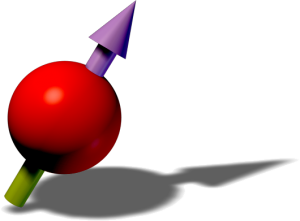by Albert Frisch
Abstract:
Since the preparation of the first Bose-Einstein condensate about two decades ago and the first degenerate Fermi gas following four years later a plethora of fascinating quantum phenomena have been explored. The vast majority of experiments focused on quantum degenerate atomic gases with short-range contact interaction between particles. Atomic species with large magnetic dipole moments, such as chromium, dysprosium, and erbium, offer unique possibilities to investigate phenomena arising from dipolar interaction. This kind of interaction is not only long-range but also anisotropic in character and imprints qualitatively novel features on the system. Prominent examples are the d-wave collapse of a dipolar Bose-Einstein condensate of chromium atoms realized by the group in Stuttgart, the spin magnetization and demagnetization dynamics observed by groups in Stuttgart, Paris, and Stanford, and the deformation of the Fermi surface observed by our group in Innsbruck. This thesis reports on the creation and study of the first Bose-Einstein condensate and degenerate Fermi gas of erbium atoms. Erbium belongs to the lanthanide group of elements and has a large magnetic moment of seven Bohr magneton. In particular, this thesis describes the experimental apparatus and the sequence for producing a dipolar quantum gas. There is an emphasis on the production of the narrow-line magneto-optical trap of erbium since this represents a very efficient and robust laser-cooling scheme that greatly simplifies the experimental procedure. After describing the experimental setup this thesis focuses on several fundamental questions related to the dipolar character of erbium and to its lanthanide nature. A first set of studies centers on the scattering properties of ultracold erbium atoms, including the elastic and the inelastic cross section and the spectrum of Feshbach resonances. Specifically, we observe that identical dipolar fermions do collide and rethermalize even at low temperatures. The corresponding elastic cross section predicted by the theory of universal dipolar scattering scales only with the particle´s mass and its magnetic moment and is temperature independent. This represents a dramatic difference compared to non-dipolar fermions, which exhibit a rapidly vanishing elastic cross section at lower temperatures. Another distinctive feature of erbium is its spectrum of Feshbach resonances. Using bosonic erbium we observed an enormous density of resonances exceeding that of alkali metals by at least a factor of ten. We statistically analyzed the spectrum in terms of the random matrix theory and demonstrated that the resonances bare a strong correlation to each other. We identify the origin of this correlation in the highly anisotropic van der Waals interaction potential of erbium. This is a phenomenon not previously encountered in ultracold quantum gases. At the many-body level we observed the d-wave collapse of the Bose-Einstein condensate as previously observed in the chromium experiment in Stuttgart. With the dipolar Fermi gas we demonstrated that the Fermi surface deforms into an ellipsoid induced by the action of the dipole-dipole interaction in momentum space.
Reference:
Dipolar Quantum Gases of Erbium,
Albert Frisch,
PhD Thesis, 2014.
Albert Frisch,
PhD Thesis, 2014.
Bibtex Entry:
@article{FrischPhD,
title = {Dipolar Quantum Gases of Erbium},
author = {Frisch, Albert},
journal = {PhD Thesis},
year = {2014},
month = {Oct},
abstract = {Since the preparation of the first Bose-Einstein condensate about two decades ago and the
first degenerate Fermi gas following four years later a plethora of fascinating quantum
phenomena have been explored. The vast majority of experiments focused on quantum
degenerate atomic gases with short-range contact interaction between particles.
Atomic species with large magnetic dipole moments, such as chromium, dysprosium,
and erbium, offer unique possibilities to investigate phenomena arising from dipolar interaction.
This kind of interaction is not only long-range but also anisotropic in character and imprints
qualitatively novel features on the system. Prominent examples are the d-wave collapse of
a dipolar Bose-Einstein condensate of chromium atoms realized by the group in Stuttgart,
the spin magnetization and demagnetization dynamics observed by groups in Stuttgart,
Paris, and Stanford, and the deformation of the Fermi surface observed by our group in Innsbruck.
This thesis reports on the creation and study of the first Bose-Einstein condensate and
degenerate Fermi gas of erbium atoms. Erbium belongs to the lanthanide group of elements
and has a large magnetic moment of seven Bohr magneton. In particular, this thesis describes
the experimental apparatus and the sequence for producing a dipolar quantum gas. There
is an emphasis on the production of the narrow-line magneto-optical trap of erbium since
this represents a very efficient and robust laser-cooling scheme that greatly simplifies the
experimental procedure.
After describing the experimental setup this thesis focuses on several fundamental questions
related to the dipolar character of erbium and to its lanthanide nature. A first set of studies
centers on the scattering properties of ultracold erbium atoms, including the elastic and the
inelastic cross section and the spectrum of Feshbach resonances. Specifically, we observe
that identical dipolar fermions do collide and rethermalize even at low temperatures. The
corresponding elastic cross section predicted by the theory of universal dipolar scattering
scales only with the particle´s mass and its magnetic moment and is temperature independent.
This represents a dramatic difference compared to non-dipolar fermions, which exhibit a rapidly
vanishing elastic cross section at lower temperatures. Another distinctive feature of erbium
is its spectrum of Feshbach resonances. Using bosonic erbium we observed an enormous density
of resonances exceeding that of alkali metals by at least a factor of ten. We statistically
analyzed the spectrum in terms of the random matrix theory and demonstrated that the resonances
bare a strong correlation to each other. We identify the origin of this correlation in the highly
anisotropic van der Waals interaction potential of erbium. This is a phenomenon not previously
encountered in ultracold quantum gases. At the many-body level we observed the d-wave collapse
of the Bose-Einstein condensate as previously observed in the chromium experiment in Stuttgart.
With the dipolar Fermi gas we demonstrated that the Fermi surface deforms into an ellipsoid
induced by the action of the dipole-dipole interaction in momentum space.},
url = {http://www.erbium.at/FF/wp-content/uploads/2015/10/thesis_albert_frisch.pdf},
}
